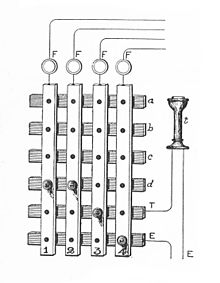
Back Koordinatenschalter German Koordinata maŝino Esperanto Conmutador de barras cruzadas Spanish کلید میلتقاطعی Persian Sistema pentaconta Italian クロスバースイッチ Japanese Kruisschakelaar (telefonie) Dutch Koordinatvelger NB Wybierak (automatyka) Polish Koordinatväljare Swedish
This article needs additional citations for verification. (January 2008) |

In electronics and telecommunications, a crossbar switch (cross-point switch, matrix switch) is a collection of switches arranged in a matrix configuration. A crossbar switch has multiple input and output lines that form a crossed pattern of interconnecting lines between which a connection may be established by closing a switch located at each intersection, the elements of the matrix. Originally, a crossbar switch consisted literally of crossing metal bars that provided the input and output paths. Later implementations achieved the same switching topology in solid-state electronics. The crossbar switch is one of the principal telephone exchange architectures, together with a rotary switch, memory switch,[2] and a crossover switch.
- ^ Kennedy, Rankin (1903 edition (five volumes) of pre-1903 four volume edition.) Electrical Installations, vol. V, London: Caxton
- ^ "Crossbar Systems – Telecommunications Heritage Group". Retrieved 2023-05-03.